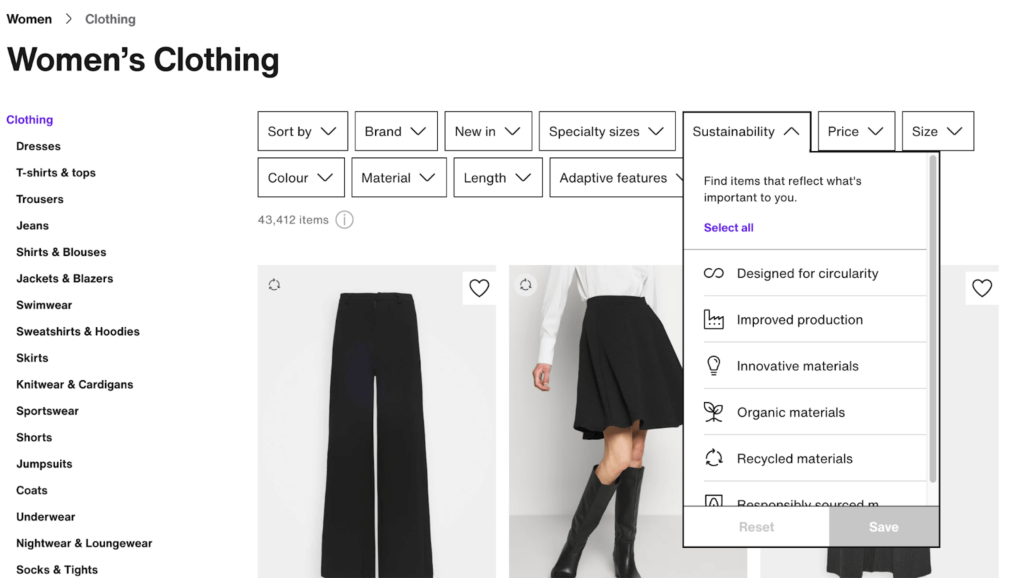Introduction
In an era of heightened environmental consciousness, retailers and brands are stepping up to the plate by weaving sustainability into the very fabric of their customer journeys.
By doing so, they are not only meeting the growing demands of eco-conscious consumers but improving their retailer’s bottom line.
Four best practices for sustainable UX
Here are four best practices that illustrate how forward-thinking retailers are successfully incorporating environmental sustainability into different steps of the online purchase journey:

1. Empower users to make sustainable choices during the search phase
Leading brands and retailers empower customers to make sustainable choices by integrating sustainable filters into their website’s search, enabling customers to effortlessly refine their choices based on eco-friendly criteria, such as materials, certifications, or product energy efficiency. These sustainability-focused filters provide customers with the ability to align their values with their purchases, granting them the power to select products that meet their environmental preferences.
For instance, European fashion online platform Zalando empowers its customers to make sustainable choices by enabling them to filter their search based on different sustainability criteria that matter to them (e.g., organic materials, responsibly sourced materials etc.).

2. Provide transparent product information during the decision-making phase
Brands and retailers that prioritise sustainability in the customer’s online purchase journey provide transparent and easy-to-understand information concerning the environmental impact of the products they sell, the materials they use, and the suppliers they partner with. They also establish trust among buyers by showcasing evidence of eco-labels and certifications the products have received (e.g., Fair Trade, Cradle to Cradle Certified, Bluesign® Approved etc.).
For example, global sports retailer Decathlon includes on each product page of its French website concise information about the environmental impact of the product, and its equivalent in car mileage for a better understanding. It also encourages users to delve deeper into the topic by providing a link to learn more about carbon footprint and its measurement.

3. Offer sustainable options during the purchase phase
Forward-thinking retailers and brands are exploring innovative shipping options like consolidated or carbon-neutral deliveries to minimise the ecological footprint of transportation. Through informative communication on their websites and during the checkout process, these brands provide insights into carbon emissions and offsetting efforts associated with deliveries, empowering customers to make eco-conscious choices.
International outdoor apparel and equipment brand The North Face provides customers with the choice between standard delivery and delivery at a collection point, clearly indicating which delivery method carries the lowest carbon impact. This educative approach raises awareness about the environmental implications of shipping choices and encourages customers to opt for more sustainable options.

4. Create initiatives to promote circular economy and bring back customers
Leading retailers and brands are embracing the principles of the circular economy by incorporating initiatives such as take-back programs, product refurbishment, and recycling incentives. They encourage customers to return old items for repurposing, reducing waste and extending the lifespan of products.
For instance, the outdoor retailer REI offers a program that enables customers to trade-in unwanted old gear and products for a gift card. REI then closes the loop: they inspect the returned items and resell them on their website, enabling eco-conscious or budget-conscious consumers to shop pre-used items at discounted rates.

We help retailers become more sustainable
Over the years, we have collaborated with numerous retail and e-commerce clients, researching and designing effective, efficient, and satisfying purchase journeys. We have assisted companies like M&S, The Body Shop, Tesco, and John Lewis in meeting their customer needs without compromising their business objectives.
Now, we also guide our clients in addressing both their customer and business needs without compromising the planet’s well-being. In the realms of UX, CX, and Service Design, we’ve observed a shift from sustainability being a ‘nice-to-have’ to a ‘must-have’. Users now expect clear, upfront information about a product or service’s impact on the environment, and they demand brands to offer eco-friendly options.
Sustainable UX services
Reach out to us if you want to:
- Discover your customers’ sustainability needs and frustrations when it comes to choosing, buying, using, or returning your products/services.
- Embed sustainability into your user journeys.
- Recognise the planet as a stakeholder in your service blueprints.
- Present sustainability information in a manner that aligns with user expectations and avoids the perception of greenwashing.
- Test which sustainable user flow is more effective.
- Understand how your competitors are faring.
- Benchmark against the best practices in the industry.
- Receive sustainable UX and UI recommendations for your designs.
- Incorporate the topic of sustainability into your research and design briefs.
- Gather user feedback on your sustainability claims, green features, renewable options, and circular service concepts.
- Facilitate ideation sessions with your users or stakeholders on the topic of environmental sustainability
- Find out anything else related to UX/CX, we are here for any requests.





